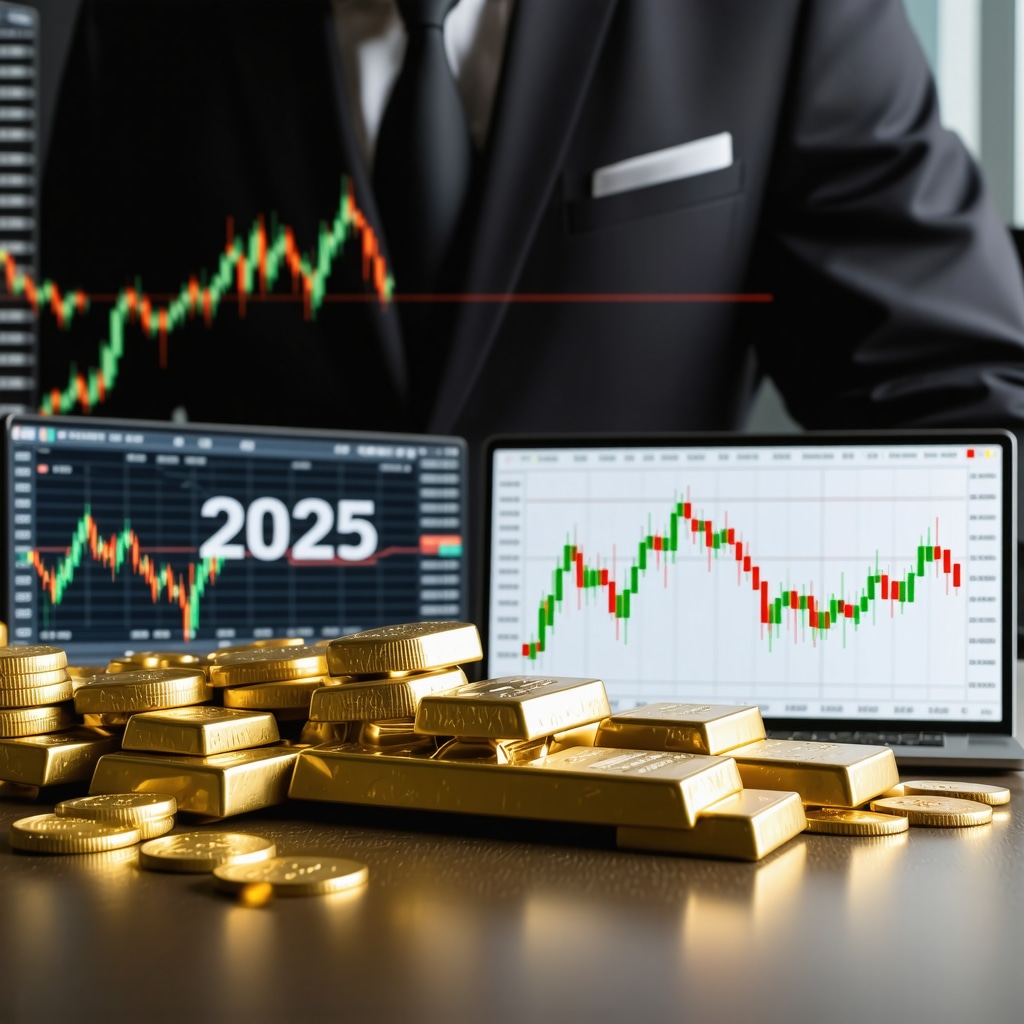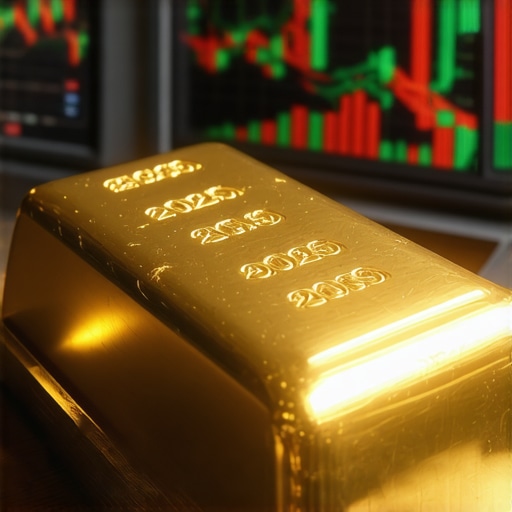Advanced Insights into Gold Market Dynamics for 2025
The gold market in 2025 presents a complex interplay of economic, geopolitical, and technological factors that demand sophisticated analysis to understand price trajectories accurately. Beyond traditional supply and demand, investors must consider macroeconomic indicators, central bank policies, and emerging financial instruments that influence gold’s valuation in unprecedented ways. This article delves into these multi-layered trends, providing a nuanced framework for professionals and seasoned investors to interpret gold market signals with greater precision.
Macroeconomic Forces and Their Intricate Impact on Gold Prices
Gold’s role as a hedge against inflation and currency volatility remains paramount. However, in 2025, the interaction between persistent inflationary pressures and central banks’ tightening monetary policies creates a paradoxical environment. While rate hikes conventionally suppress gold prices due to increased opportunity costs, ongoing geopolitical tensions and uncertain global growth prospects sustain gold’s safe-haven appeal. Additionally, the Federal Reserve’s nuanced stance on interest rates, combined with divergent policies from the European Central Bank and People’s Bank of China, injects significant volatility and regional demand disparities into the market.
How Do Central Bank Gold Purchases Influence Market Dynamics in 2025?
Central banks continue to be dominant players in gold demand, strategically accumulating reserves to diversify foreign exchange holdings and bolster financial resilience. In 2025, increased purchases by emerging market central banks, particularly in Asia and the Middle East, reflect a strategic shift away from traditional reserve currencies. This trend not only elevates physical gold demand but also signals potential shifts in geopolitical alliances that could further affect market sentiment and price trajectories. For a detailed exploration of how central bank activities shape gold demand, see Understanding Central Bank Gold Purchases and Their Impact on Prices.
Technological Innovations and Their Emerging Role in Gold Trading
The integration of blockchain technology and algorithmic trading platforms is revolutionizing gold market liquidity and transparency. Smart contracts and tokenized gold assets enable fractional ownership and seamless cross-border transactions, broadening market participation beyond traditional institutional investors. These technological advances introduce new variables in price discovery mechanisms and present challenges in regulatory oversight, potentially affecting volatility and investment strategies.
Strategic Portfolio Positioning Amidst Volatile Market Conditions
Incorporating gold within diversified portfolios requires a keen understanding of asset correlations and risk mitigation tactics amid 2025’s uncertain economic landscape. Investors increasingly leverage gold ETFs and mutual funds alongside physical bullion to balance liquidity and security. Strategies that combine gold with equities, bonds, and alternative assets can optimize portfolio resilience, especially during inflationary cycles and geopolitical disruptions. For comprehensive strategies on balancing your investments, consider reviewing Gold vs. Stocks: Best Strategies to Balance Your Portfolio.
What Are the Most Effective Analytical Tools for Predicting Gold Price Movements in 2025?
Experts employ a blend of quantitative models, including econometric forecasting, sentiment analysis, and machine learning algorithms, to capture gold price drivers. Incorporating macroeconomic data, geopolitical risk indices, and market liquidity metrics enhances predictive accuracy. However, inherent uncertainties and market shocks necessitate adaptive models and continuous data reassessment. Utilizing multifactor models that integrate both fundamental and technical indicators remains crucial for informed decision-making.
Explore Expert-Level Resources and Contribute Your Insights
To deepen your understanding of gold investment opportunities and market analysis techniques, explore our comprehensive guide on 2025 Gold Price Forecast and Key Market Trends. Experienced investors and analysts are encouraged to share their professional insights and discuss emerging trends to foster a more robust community knowledge base.
For authoritative perspectives on gold market fundamentals, see the World Gold Council’s extensive research publications, which remain a benchmark for industry standards and market data analysis (World Gold Council Research).
Decoding Market Sentiment: Behavioral Economics in Gold Trading
Market sentiment plays a pivotal role in gold price fluctuations, often amplifying the effects of fundamental economic factors. In 2025, behavioral economics insights are increasingly integrated into gold trading strategies to capture irrational investor behaviors and herd dynamics. Sentiment indicators derived from social media analytics, news sentiment scores, and investor surveys provide real-time gauges of market mood. These tools enable traders to anticipate momentum shifts and potential reversals that traditional models may overlook. Harnessing sentiment analysis enhances decision-making in volatile environments, complementing macroeconomic and technical data.
Global Supply Chain Disruptions: A Hidden Variable for Gold Prices
While physical gold supply is traditionally stable, 2025 witnesses unprecedented challenges in mining output and logistics due to geopolitical conflicts and environmental regulations. Disruptions in key gold-producing regions, such as Africa and South America, coupled with rising extraction costs, constrain supply growth. Additionally, transport bottlenecks and trade restrictions exacerbate delays in bullion delivery, impacting market liquidity. These factors introduce a nuanced layer of supply-side risk that demands careful monitoring for accurate price forecasting and inventory management.
How Can Investors Leverage Multi-Asset Correlation Models to Optimize Gold Portfolio Performance in 2025?
Multi-asset correlation models analyze the dynamic relationships between gold, equities, bonds, currencies, and alternative assets to identify diversification benefits and risk concentrations. In 2025’s complex financial landscape, correlations are non-linear and influenced by rapid shifts in monetary policy and geopolitical events. Advanced statistical techniques, such as copulas and regime-switching models, allow investors to adapt portfolio allocations dynamically, optimizing risk-adjusted returns while maintaining exposure to gold’s safe-haven properties. Incorporating real-time data feeds and machine learning enhances the responsiveness of these models.
For those interested in practical applications of these concepts, building a balanced gold portfolio for maximum growth offers comprehensive insights tailored to 2025’s market realities.
Regulatory Evolution and Its Implications for Gold Market Participation
Regulatory frameworks governing gold trading and investment vehicles are evolving to address emerging risks associated with digital assets and cross-border transactions. Enhanced Know Your Customer (KYC) and Anti-Money Laundering (AML) policies increase transparency but also raise compliance costs. In some jurisdictions, tax treatments of gold ETFs, mutual funds, and physical holdings are being revised, influencing investor behavior. Staying abreast of regulatory changes is crucial for institutional and retail investors alike to navigate legal complexities and optimize after-tax returns.
Integrating ESG Criteria in Gold Investment Decisions
Environmental, Social, and Governance (ESG) factors are gaining prominence in gold investment strategies. Ethical sourcing, environmental impact of mining operations, and corporate governance practices influence gold producers’ valuations and investor sentiment. ESG-compliant funds and green gold certifications help investors align portfolios with sustainability goals without compromising returns. This shift underscores the importance of due diligence and engagement with producers to ensure responsible investment in the gold sector.
For an expert-level update on market fundamentals, the World Gold Council’s Research remains an indispensable resource, offering data-driven analysis and comprehensive industry reports.
Engage with the Community: Share Your Strategies and Insights
How are you adapting your gold investment approach to the complex dynamics of 2025? Share your experiences and strategies in the comments below to contribute to a collaborative learning environment. If you found this deep dive valuable, consider sharing it with your professional network to foster informed investment decisions. For further study, explore our detailed guide on Advanced Gold Investment Strategies for 2025 to expand your expertise.
Harnessing Artificial Intelligence for Enhanced Gold Price Forecasting Accuracy
In 2025, the confluence of artificial intelligence (AI) and big data analytics is reshaping the landscape of gold price forecasting. Traditional econometric models are increasingly augmented with AI-driven approaches that incorporate vast, real-time datasets, including geopolitical news feeds, social media sentiment, and macroeconomic indicators. Machine learning algorithms, particularly deep learning networks, excel at detecting subtle nonlinear patterns and regime shifts that often elude classical methods.
One pioneering application involves recurrent neural networks (RNNs) and long short-term memory (LSTM) models, which can capture temporal dependencies and volatility clustering inherent in gold price series. These models adapt dynamically, recalibrating as fresh data streams in, thereby improving predictive robustness against sudden market shocks.
Can AI-Based Sentiment Analysis Outperform Traditional Market Indicators in Gold Price Prediction?
Sentiment analysis leveraging natural language processing (NLP) techniques can parse millions of text sources—financial news, analyst reports, social media chatter—to quantify investor mood in near real-time. Studies by the Journal of Financial Data Science highlight that sentiment indices derived from AI outperform conventional lagging indicators by anticipating market turning points, particularly during geopolitical crises or economic uncertainty.
For example, a sudden surge in negative sentiment about inflation or currency devaluation can trigger increased safe-haven demand for gold, often before such factors are fully reflected in macroeconomic data releases. Integrating AI-driven sentiment scores with traditional fundamental and technical indicators forms a holistic forecasting framework that captures both psychological and structural market drivers.
Refining Risk Management: Applying Quantitative Behavioral Finance Models to Gold Investing
Behavioral finance models incorporating quantifiable investor biases—such as overconfidence, loss aversion, and herding—are gaining traction in gold trading strategies. By statistically modeling these biases, sophisticated investors can better anticipate irrational market reactions that create exploitable price anomalies.
Regime-switching models that identify shifts between risk-on and risk-off investor sentiment regimes enable dynamic portfolio rebalancing to optimize gold exposure. This approach helps navigate the complex interplay between gold’s roles as a speculative asset and a safe haven, particularly during bouts of heightened uncertainty.
Integrating Multi-Dimensional Data Streams for Real-Time Gold Market Intelligence
Advanced platforms now fuse diverse data sources—including satellite imagery monitoring mining activity, supply chain logistics, and central bank gold reserves—to provide comprehensive situational awareness. Such integration empowers traders and analysts to anticipate supply-side shocks or demand surges with unprecedented lead time.
Moreover, blockchain-based provenance tracking enhances transparency in gold sourcing, which increasingly influences ESG-compliant investment decisions. These technological innovations reinforce gold’s evolving narrative as both a financial asset and a socially responsible investment vehicle.

Regulatory Implications of Emerging Technologies in Gold Trading Ecosystems
As AI and blockchain technologies proliferate within gold markets, regulators face the challenge of balancing innovation with investor protection. Regulatory bodies are developing frameworks addressing algorithmic trading risks, data privacy, and asset tokenization to prevent market manipulation and ensure systemic stability.
Understanding these evolving regulations is critical for market participants to mitigate compliance risks and capitalize on new trading platforms. Staying informed about jurisdiction-specific policies on digital gold assets and AI-driven advisory services will be increasingly essential.
Where Can Investors Access Authoritative Data and Analytical Tools for Cutting-Edge Gold Market Research?
For researchers and investors seeking rigorous data and advanced analytical tools, the World Gold Council’s Research Portal offers an extensive repository of market insights, supply-demand statistics, and sustainability reports. Additionally, platforms such as Refinitiv and Bloomberg Quantitative Research provide customizable AI-driven analytics tailored to gold market dynamics.
For those eager to deepen their expertise on AI integration and behavioral finance applications in precious metals, consider subscribing to specialized financial data science journals and participating in industry symposiums focused on emerging market technologies.
Join the Discourse: Share Your Perspectives on AI and Behavioral Strategies in Gold Investment
How are you leveraging AI and behavioral finance insights to refine your gold investment strategies in 2025? Engage with our expert community by sharing your experiences, challenges, and innovative approaches in the comments section below. Your contributions help foster a richer understanding of these transformative market forces.
To continue exploring these advanced topics, visit our comprehensive resource on Advanced Gold Investment Strategies for 2025 and stay at the forefront of market evolution.
Deciphering Complex Volatility Patterns through Advanced Econometric Techniques
In 2025, gold market volatility exhibits multifaceted characteristics that challenge conventional forecasting paradigms. Sophisticated econometric approaches such as multivariate GARCH (Generalized Autoregressive Conditional Heteroskedasticity) models enable analysts to capture time-varying volatility and cross-market spillovers with granular precision. These models are particularly adept at assessing asymmetric volatility responses to macroeconomic shocks and geopolitical disturbances, thus refining risk assessment and hedging strategies.
Quantum Computing Prospects in Gold Price Modeling: The Next Frontier?
While still in nascent stages, quantum computing holds transformative potential for processing complex datasets and running high-dimensional simulations relevant to gold price dynamics. Quantum algorithms could exponentially accelerate scenario analyses, optimize portfolio allocations, and solve previously intractable optimization problems in real time. Anticipating regulatory frameworks and infrastructure adaptations to accommodate quantum-enabled financial modeling is becoming a strategic consideration for forward-looking investors.
How Will Quantum Machine Learning Transform Gold Market Predictive Analytics?
Quantum machine learning (QML) integrates quantum computing with traditional AI methodologies to uncover intricate patterns within gold market data that classical algorithms might miss. By leveraging qubit superposition and entanglement, QML models can analyze multidimensional datasets simultaneously, enhancing prediction accuracy for price movements and volatility clustering. Early research from Nature Quantum Information showcases promising applications of QML in financial time series forecasting, signaling a paradigm shift in quantitative finance.
Tailoring Hedging Strategies Using Dynamic Scenario Analysis and Stress Testing
Incorporating dynamic scenario analysis that models extreme but plausible events—such as sudden policy shifts or supply chain breakdowns—allows portfolio managers to stress-test gold holdings under varying conditions. Utilizing Monte Carlo simulations combined with regime-switching frameworks facilitates more resilient hedging tactics, ensuring portfolios remain robust against unforeseen systemic risks.
Synergizing ESG Integration with Advanced Impact Analytics
Beyond traditional ESG metrics, cutting-edge impact analytics quantify the tangible environmental and social outcomes associated with gold mining operations. Leveraging geospatial analytics and real-time environmental monitoring enables investors to align strategies with sustainable development goals more precisely. This data-driven ESG integration fosters enhanced transparency and accountability in gold supply chains, which increasingly influence long-term asset valuation.
Inviting Expert Collaboration: Elevate Your Gold Market Strategy
Engage with our community of seasoned analysts and quantitative finance experts to discuss these emerging methodologies and regulatory trends shaping the gold market in 2025. Share your perspectives, innovative models, or quantum computing insights in the comments below. For an in-depth exploration of these advanced topics, visit our resource hub on Advanced Gold Investment Strategies for 2025 and position yourself at the forefront of gold market innovation.
Expert Insights & Advanced Considerations
Central Banks as Strategic Catalysts in Gold Demand
In 2025, central banks—especially those in emerging markets—continue to reshape gold market fundamentals by diversifying reserves away from traditional fiat currencies. This strategic accumulation not only underpins physical demand but also signals deeper geopolitical realignments that seasoned investors must monitor closely. Understanding these central bank behaviors enhances the ability to anticipate shifts in gold price momentum beyond conventional economic indicators. For further details, explore insights on central bank gold purchases and their market impact.
AI-Driven Sentiment Analysis: A Paradigm Shift in Forecasting Accuracy
The integration of artificial intelligence, particularly natural language processing techniques, has revolutionized gold price forecasting by capturing nuanced investor sentiment from vast data streams in real time. These AI-generated sentiment indices often precede traditional market indicators in signaling turning points, especially during geopolitical or economic upheavals. Incorporating such advanced analytics alongside fundamental and technical data offers sophisticated investors a competitive edge in volatile markets.
Multi-Asset Correlation Models for Dynamic Portfolio Optimization
Gold’s role as a portfolio diversifier in 2025 demands a deeper understanding of its non-linear correlations with equities, bonds, and alternative assets amidst fluctuating monetary policies. Employing advanced statistical frameworks such as regime-switching and copulas enables investors to dynamically adjust allocations, balancing risk and return more effectively. This approach is essential for refining portfolio resilience in the face of complex global economic uncertainties. Practical applications of these concepts can be found in building a balanced gold portfolio.
ESG Integration as a Critical Investment Filter
Environmental, Social, and Governance criteria have shifted from peripheral considerations to central pillars in gold investment decisions. Investors increasingly demand transparency on ethical sourcing and mining impacts, with ESG-compliant funds gaining traction. This evolution not only influences valuations but also shapes long-term market sentiment, requiring due diligence and active engagement with producers to align portfolios with sustainability imperatives.
Quantum Computing: The Emerging Frontier in Gold Market Analytics
Though still nascent, quantum machine learning promises to transform gold price modeling by processing complex, multidimensional datasets far beyond classical computational limits. Early research suggests significant potential for uncovering hidden patterns and enhancing predictive accuracy, signaling a future where quantum-enabled analytics become integral to cutting-edge gold investment strategies.
Curated Expert Resources
World Gold Council Research Portal: The definitive source for comprehensive market data, supply-demand analysis, and sustainability reports, invaluable for professionals seeking authoritative insights.
Refinitiv: Offers customizable AI-driven analytics and real-time data feeds tailored to gold market dynamics, supporting sophisticated quantitative research.
Bloomberg Quantitative Research: Provides advanced tools and datasets for integrating econometric models and sentiment analysis into gold price forecasting.
Nature Quantum Information Journal: Contains pioneering studies on quantum machine learning applications relevant to financial forecasting, including precious metals markets.
BuyingGoldNow Advanced Strategies Hub: A specialized repository featuring in-depth guides and evolving methodologies for gold investment and trading in 2025.
Final Expert Perspective
Navigating the gold market in 2025 requires an integrative approach that synthesizes macroeconomic trends, geopolitical developments, technological innovations, and ESG imperatives. Central bank activities remain a fundamental driver, while AI and emerging quantum technologies redefine forecasting horizons. Incorporating advanced multi-asset correlation models and behavioral finance insights enhances portfolio resilience amid volatility. The evolving regulatory landscape and increasing emphasis on sustainability further complicate the investment landscape but also create novel opportunities for discerning professionals. Engage with these dimensions thoughtfully to refine your gold investment strategies. Share your expert perspectives and explore our comprehensive resources to stay at the forefront of this dynamic market environment.










